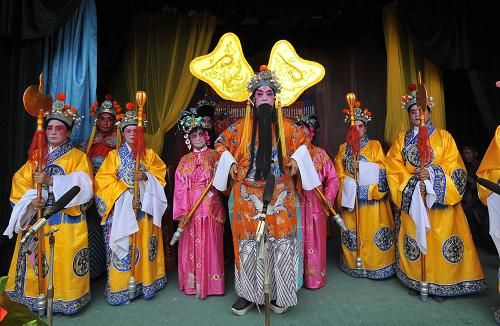 |
|
Hop Opera[www.baidu.com]
|
Dang Zhongxin was born to a farming family in Heyang County, Weinan City of Shaanxi Province. Influenced by his family’s interests, he began to learn the art of the indigenous Hop Opera at a young age. With his exquisite makeup and outstanding performing skills, Dang was a firm favorite with local audiences. During the "cultural revolution" (1966-1976), Dang risked his personal safety to rescue more than 30 volumes of antique opera scripts from being burnt. In recognition of his devotion to this ancient art form, in 2009, he was nominated an inheritor of national intangible cultural heritage.
THE reporter met Dang Zhongxin in a newly opened nursing home in Heyang County. The 67-year-old and his wife live beside the main gate on the ground floor. This is particularly convenient for his new job as janitor.
The couple moved to the town at their son’s suggestion, as they were getting too old to grow crops. Instead of sitting bored at home, Dang soon found a job as a janitor. "In our village, we would often visit our neighbors and talk with people we met. When we moved to town, we didn’t know anyone. It was boring and lonely for us. But my job means I can meet and interact with people daily."
A Living Fossil
Dang was born in Xingjiazhuang, a village 20 miles from Heyang County where the traditional Chinese art form Hop Opera has been performed and admired for centuries.
There are no written records on the origins of this form of opera; its history can be traced to around the 13th century. Unlike other traditional drama forms in China, Hop Opera has neither professional artists nor specialized troupes. Instead it is performed by amateurs for their fellow villagers. It is, thus, a cultural activity specifically for the entertainment of farming communities.
Hop Opera, as the name suggests, is based on basic rhythms and a distinct jumping style. Every move and step the player makes resembles ancient worship rites, so the performance appears primitive but powerful. It is, therefore, classified as a type of Nuoxi Opera, a crude and wild folk art form originating in sacrificial rituals of the distant past.
The musical instruments used in Hop Opera include gongs, bass drums, cymbals and other percussion. Some plays may involve the suona trumpet, but string instruments never feature. The performance is a dance, and the actors tell rather than sing stories.
Dang recalled the traditions of Hop Opera in his village: Every year during the last month of the Chinese lunar calendar, villagers would start to rehearse the opera because by then, their farming work was done. Those rehearsals served as preparation for performances during the coming Spring Festival. Beginning from the fifth day of the new lunar year, opera actors would eagerly change into their costumes before sunrise and each team would make their way to their designated performance area. The opera, thus, lifted its curtain annually. By the 15th day of the new lunar year, a Hop carnival would be in full swing throughout the village. When the buzz died down, performers would store their costumes and instruments until the next year. For the rest of the year, they were just ordinary farmers, busy with their families and agricultural work.
We Recommend:
